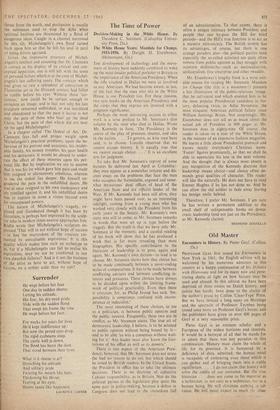The Time of Power
The White House Years: Mandate for Change, 1953-1956. By Dwight D. Eisenhower. (Heinemann, 63s.) TtiE development of technology and the move- ment of history have suddenly combined to wake tip the most insular political potholer in Britain to the importance of the American Presidency. When the rifle cracked in Dallas we were as involved as any American. We had become aware, at last, of the fact that the man who sits in the White House is our President too. For these reasons, • two new books on the .American Presidency and the views that they express are invested with a poignant significance.
Perhaps the most interesting section in either work is a terse preface to Mr. Sorensen's slim
1,oluriie by the man who died in Dallas. Wrote
Mr. Kennedy in June, 'The 'Presidency is the centre of the play of pressure, interest,.and idea in the nation. . . To govern, as wise men have said, is to choose. Lincoln observed that we cannot escape history. It is equally true that .we cannot escape choice. . . .' It is an excellent text for judgment.
To take first Mr. Sorensen's reprint of some lectures he delivered last April at Columbia: they may appear as a somewhat reticent and dis- • erect essay on the problems that face the man who occupies the 'formidable, exposed and some- what mysterious' dual offices of head of the American State and (ex officio) leader of the West. If Mr. Kennedy had been still alive, they might have been passed over, as an interesting sidelight, coming from a young man who has worked very closely with the President from his early years in the Senate. Mr. Kennedy's own story was still to come, as Mr. Sorensen remarks in words that were set up in type before the tragedy. But the truth is that we have only Mr.
Sorensen at the moment; and a careful reading of his book will show that he has produced a work that is far more revealing than most biographies. His specific contributjon to the literature of leadership is to pose, again and again, Mr. Kennedy's own dictum—to lead is to choose. Mr. Sorensen shows how that choice has to be made continually between a never-ending series of computations. It has to be made between conflicting advisers and between conflicting in- terests and pressures. These choices have always to be decided upon within the limiting frame- work of political practicality. Even then there is criticism, for, as Philip Jessup has said, 'Im- possibility is sometimes confused with incom- petence or indecision.'
The most interesting of these choices, to me as a politician, is between public opinion and the public interest. Frequently, these two are in conflict, as Mr. Sorensen states. The true art of democratic leadership, I believe, is to be attuned
to public opinion without being bound by it— ,and to be able `to win a consensus without wait- ing for it.' Any leader must also 'know the limi- tations of his office as well as its powers.'
There is one aspect of the • American Presi- dency, however, that Mr. Sorensen does not stress (he had no reason to do so), but which should be noted by British readers. In the United States, the President in office has to take the ultimate decisions. There is no , doctrine of collective Cabinet responsibility, as in Britain. Nor do the political parties in the legislature play quite the same part in policy-making, because a defeat in Congress does not lead to the immediate fall of an administration. To that extent, there is often a unique intimacy between President and people that can by-pass the Hill for brief periods--and the Hill's true function is to act as a massive veto-society. The British system has its advantages, of course, but there is one strange paradox also—the political parties (and especially the so-called activists) are quite often remote from public opinion as they struggle with outworn shibboleths—such as nationalisation, unilateralism, free enterprise and other twaddle.
Mr. Eisenhower's lengthy book is a most suit- able reason for reading Mr. Sorensen. Mandate for Change (the title is a misnomer!) presents a fair illustration of the public-relations 'image that he cultivated and which enabled him to be the most popular Presidential candidate in his- tory, defeating twice, in Adlai Stevenson, the most eloquent American political failure since William Jennings Bryan. Not surprisingly, Mr. Eisenhower does not tell us as much about the actual job of President in 600 pages as Mr. Sorensen does in eighty-nine. Of course, the reader is taken on a tour of the White House, in the manner of an expensive fashion magazine. He learns a little about Presidential protocol and knows nearly everybody's Christian name. 'Foster' figures prominently, so that we shall be able to appreciate his loss in the next volume. And the thought that is always most absent is any recognition of the Kennedy doctrine that leadership means choice—and choice often de- mands great qualities of character. The reader will like Ike naturally. He does not have to read Emmet Hughes if he has not done so. And he can allow the old soldier to fade away leaving his benign smile behind.
Therefore, I prefer Mr. Sorensen. I am sure he has written a permanent addition to the small shelf of indispensable books on demo- cratic leadership (and not just on the Presidency, as Mr. Kennedy claims).
DESMOND DONNELLY






























 Previous page
Previous page